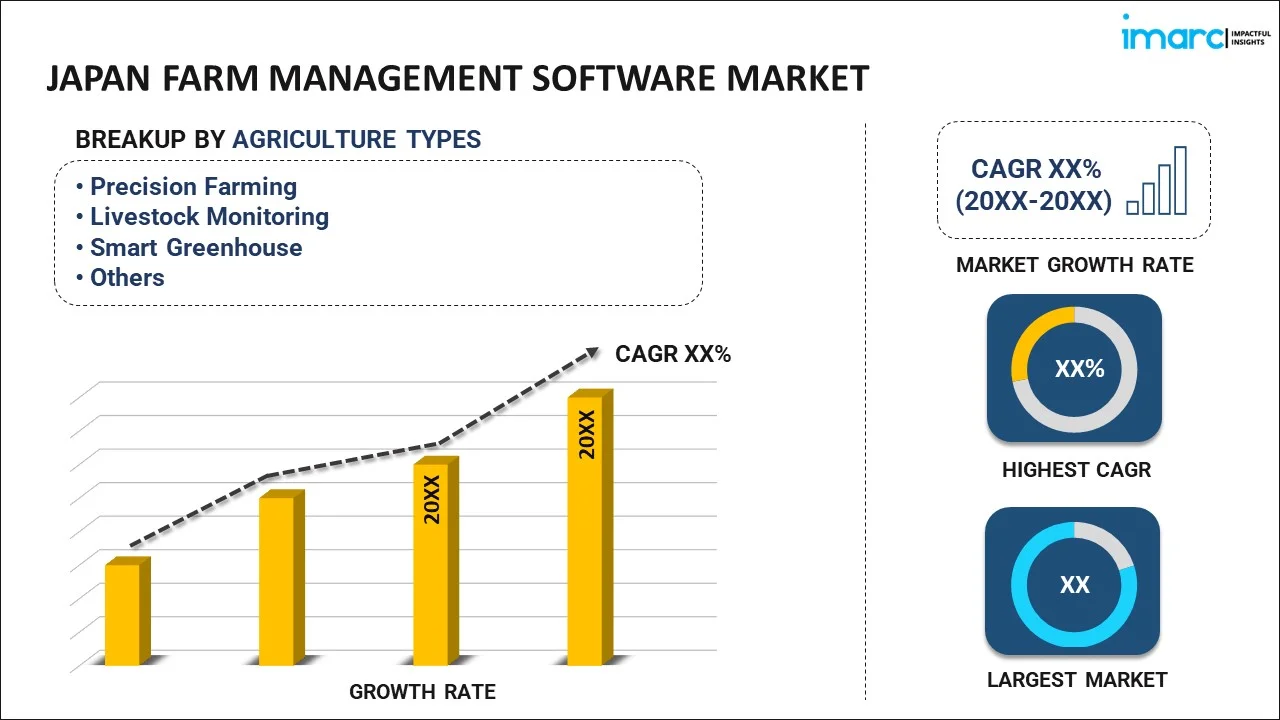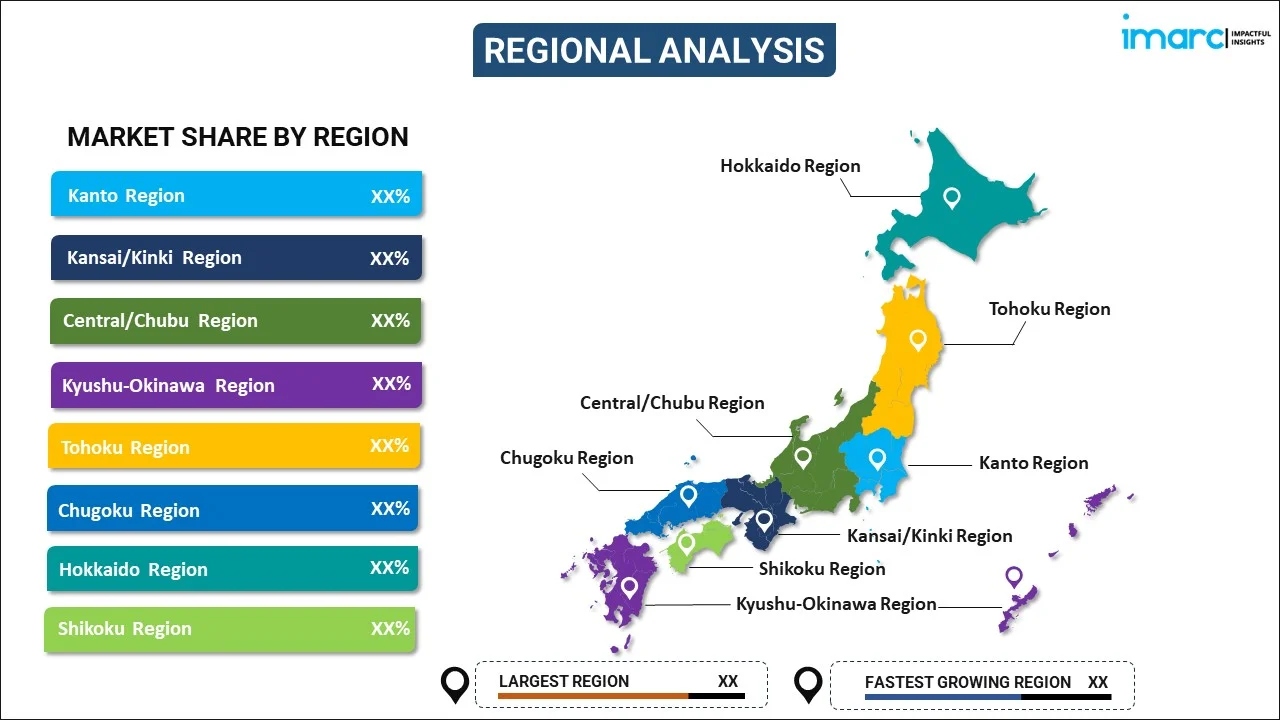
Japan Farm Management Software Market Report by Agriculture Type (Precision Farming, Livestock Monitoring, Smart Greenhouse, Fish Farming, and Others), Deployment Mode (On-premises, Cloud-based), Service (System Integration and Consulting, Maintenance and Support, Managed Services, Assisted Professional Services), and Region 2025-2033
Market Overview:
Japan farm management software market size reached USD 183.3 Million in 2024. Looking forward, IMARC Group expects the market to reach USD 463.2 Million by 2033, exhibiting a growth rate (CAGR) of 10.80% during 2025-2033. The scarcity of skilled labor and arable land is pushing the agricultural sector to adopt data-driven solutions for optimizing crop yields, which is primarily driving the market growth.
|
Report Attribute
|
Key Statistics
|
|---|---|
|
Base Year
|
2024 |
|
Forecast Years
|
2025-2033
|
|
Historical Years
|
2019-2024
|
| Market Size in 2024 | USD 183.3 Million |
| Market Forecast in 2033 | USD 463.2 Million |
| Market Growth Rate (2025-2033) | 10.80% |
Farm management software is a valuable tool for agricultural practitioners, aiding in the streamlined management of daily farming activities. This software automates the collection and storage of crucial farm data, oversees and assesses farm operations and resource utilization, and monitors financial aspects like business expenses and budgeting. It encompasses a range of features, including farm financial management with integrated accounting capabilities, tools for farm planning and procurement, as well as marketing and budget management functionalities. Moreover, it plays a pivotal role in centralizing, overseeing, and optimizing various production activities on farms. By facilitating strategic planning and enhancing efficiency in their day-to-day tasks, farm management software is witnessing a growing demand among farming professionals in Japan. This technology empowers farmers to make informed decisions, improve productivity, and ensure the sustainable management of their agricultural operations. As a result, the adoption of farm management software is on the rise, as it addresses the evolving needs of the agricultural sector in Japan.
Japan Farm Management Software Market Trends:
The Japan market is witnessing a positive growth trajectory, primarily driven by the significant global food shortage resulting from the growing population. Farm management software plays a pivotal role in enhancing farm efficiency and animal health through predictive analytics and insightful data outputs. Its adoption is widespread due to various advantages such as precise traceability, reduced costs in labor and inputs, and improved planning and tracking capabilities, further bolstering market growth. Technological advancements, including the integration of Internet of Things (IoT), artificial intelligence (AI), and machine learning (ML) for real-time activity tracking, automated record-keeping, increased efficiency, and data-driven decision-making, are key contributors to the market's expansion. Additionally, the increasing use of cloud-based platforms in agriculture, facilitated by readily available high-speed internet connectivity, is positively impacting the market. Factors such as the growing demand for livestock performance monitoring, extensive research and development (R&D) initiatives, and government initiatives promoting chemical-free fertilizers are anticipated to further drive market growth over the forecasted period.
Japan Farm Management Software Market Segmentation:
IMARC Group provides an analysis of the key trends in each segment of the market, along with forecasts at the country level for 2025-2033. Our report has categorized the market based on agriculture type, deployment mode, and service.
Agriculture Type Insights:

- Precision Farming
- Livestock Monitoring
- Smart Greenhouse
- Fish Farming
- Others
The report has provided a detailed breakup and analysis of the market based on the agriculture type. This includes precision farming, livestock monitoring, smart greenhouse, fish farming, and others.
Deployment Mode Insights:
- On-premises
- Cloud-based
A detailed breakup and analysis of the market based on the deployment mode have also been provided in the report. This includes on-premises and cloud-based.
Service Insights:
- System Integration and Consulting
- Maintenance and Support
- Managed Services
- Assisted Professional Services
The report has provided a detailed breakup and analysis of the market based on the service. This includes system integration and consulting, maintenance and support, managed services, and assisted professional services.
Regional Insights:

- Kanto Region
- Kansai/Kinki Region
- Central/ Chubu Region
- Kyushu-Okinawa Region
- Tohoku Region
- Chugoku Region
- Hokkaido Region
- Shikoku Region
The report has also provided a comprehensive analysis of all the major regional markets, which include Kanto Region, Kansai/Kinki Region, Central/ Chubu Region, Kyushu-Okinawa Region, Tohoku Region, Chugoku Region, Hokkaido Region, and Shikoku Region.
Competitive Landscape:
The market research report has also provided a comprehensive analysis of the competitive landscape in the market. Competitive analysis such as market structure, key player positioning, top winning strategies, competitive dashboard, and company evaluation quadrant has been covered in the report. Also, detailed profiles of all major companies have been provided.
Japan Farm Management Software Market Report Coverage:
| Report Features | Details |
|---|---|
| Base Year of the Analysis | 2024 |
| Historical Period | 2019-2024 |
| Forecast Period | 2025-2033 |
| Units | Million USD |
| Scope of the Report | Exploration of Historical Trends and Market Outlook, Industry Catalysts and Challenges, Segment-Wise Historical and Future Market Assessment:
|
| Agriculture Types Covered | Precision Farming, Livestock Monitoring, Smart Greenhouse, Fish Farming, Others |
| Deployment Modes Covered | On-premises, Cloud-based |
| Services Covered | System Integration and Consulting, Maintenance and Support, Managed Services, Assisted Professional Services |
| Regions Covered | Kanto Region, Kansai/Kinki Region, Central/ Chubu Region, Kyushu-Okinawa Region, Tohoku Region, Chugoku Region, Hokkaido Region, Shikoku Region |
| Customization Scope | 10% Free Customization |
| Post-Sale Analyst Support | 10-12 Weeks |
| Delivery Format | PDF and Excel through Email (We can also provide the editable version of the report in PPT/Word format on special request) |
Key Questions Answered in This Report:
- How has the Japan farm management software market performed so far and how will it perform in the coming years?
- What has been the impact of COVID-19 on the Japan farm management software market?
- What is the breakup of the Japan farm management software market on the basis of agriculture type?
- What is the breakup of the Japan farm management software market on the basis of deployment mode?
- What is the breakup of the Japan farm management software market on the basis of service?
- What are the various stages in the value chain of the Japan farm management software market?
- What are the key driving factors and challenges in the Japan farm management software?
- What is the structure of the Japan farm management software market and who are the key players?
- What is the degree of competition in the Japan farm management software market?
Key Benefits for Stakeholders:
- IMARC’s industry report offers a comprehensive quantitative analysis of various market segments, historical and current market trends, market forecasts, and dynamics of the Japan farm management software market from 2019-2033.
- The research report provides the latest information on the market drivers, challenges, and opportunities in the Japan farm management software market.
- Porter's five forces analysis assist stakeholders in assessing the impact of new entrants, competitive rivalry, supplier power, buyer power, and the threat of substitution. It helps stakeholders to analyze the level of competition within the Japan farm management software industry and its attractiveness.
- Competitive landscape allows stakeholders to understand their competitive environment and provides an insight into the current positions of key players in the market.
Need more help?
- Speak to our experienced analysts for insights on the current market scenarios.
- Include additional segments and countries to customize the report as per your requirement.
- Gain an unparalleled competitive advantage in your domain by understanding how to utilize the report and positively impacting your operations and revenue.
- For further assistance, please connect with our analysts.
 Request Customization
Request Customization
 Speak to an Analyst
Speak to an Analyst
 Request Brochure
Request Brochure
 Inquire Before Buying
Inquire Before Buying




.webp)




.webp)












